1 of 18
Downloaded 27 times




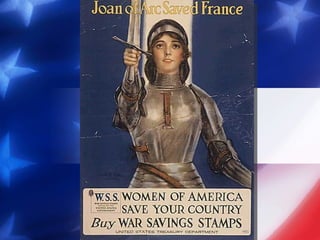


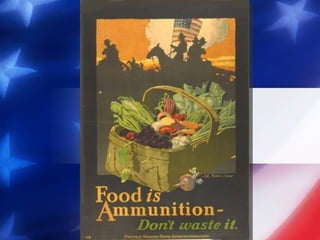


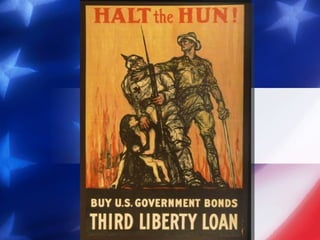
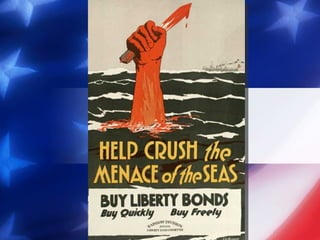
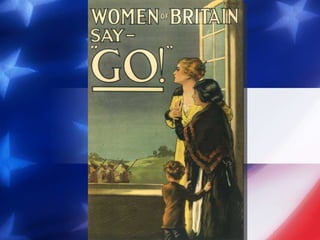
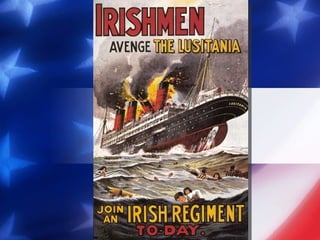

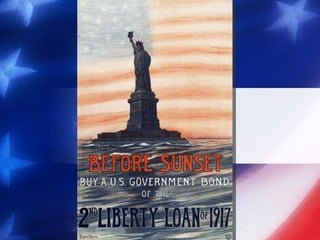


Ad
Recommended
WWII Propaganda
WWII PropagandaMarva Fonseca
╠²
Pearl Harbor was attacked by 353 Japanese aircraft in two waves on December 7, 1941, killing 2,402 Americans and wounding 1,282. During WWII, approximately 400,000 US women served in the armed forces and more than 543 lost their lives. President Roosevelt required all Japanese Americans living on the West Coast to be imprisoned in internment camps. More than 85 million Americans purchased war bonds totaling $185.7 billion to finance the war.WWI and WWII Propaganda Poster Art
WWI and WWII Propaganda Poster ArtFrank McCormick
╠²
The document discusses the use of posters for propaganda purposes during World War I, World War II, and other conflicts. Posters were used to recruit soldiers, promote war bonds, encourage conservation, and maintain morale on the home front. The document examines many examples of propaganda posters and asks the reader to evaluate which poster from several slides would be most effective and memorable, explaining their choice.World war i propaganda posters
World war i propaganda postersmswhitehistory
╠²
This document discusses how propaganda was used during World War I, including different types of propaganda posters used by the United States to justify involvement in the war, recruit soldiers and resources, and promote patriotism and other efforts. Specifically, it examines propaganda posters related to military recruitment, conservation of goods, patriotism, women's roles, religious appeals, economic issues like buying war bonds, and children's relief efforts.Patriotism and propaganda
Patriotism and propagandaBenWinthrop
╠²
Patriotism played a large role in influencing men to join the British army during World War 1, as they felt obligated to protect their country and fellow citizens. Propaganda posters were also highly effective at appealing to men's sense of duty, honor, and pride by portraying the army in a positive light and emphasizing the need for more soldiers. These posters were designed to be easily understood by those with low literacy rates through bold images and text. A wide variety of propaganda methods were used to encourage enlistment up until conscription was enacted in 1916.Propaganda Wii Posters And Analysis
Propaganda Wii Posters And AnalysisKira Kristan
╠²
This document discusses World War II propaganda posters and their use of persuasive techniques. It defines propaganda and its goal of persuading audiences. Key techniques identified include emotional appeals, symbolism, repetition, bandwagon appeals, and invoking fear or justice. Students are then assigned the task of designing their own propaganda poster for an important cause, utilizing several of these techniques to promote awareness and action. Their posters will be graded on design, use of techniques, promoting their cause, and overall effort.Analyzing world war_i_propaganda_posters-1
Analyzing world war_i_propaganda_posters-1Jason Hoover
╠²
The document analyzes WWI propaganda posters from various countries including the US, UK, France and Germany. It discusses the common objectives of wartime propaganda such as recruiting soldiers, financing the war effort, eliminating dissent, and conserving resources. The document also examines the common tools used in propaganda posters like demonization, emotional appeals, patriotic appeals, and evocative visual symbols. Students analyze sample posters to identify the country of origin, objective, and propaganda tools used in each.Fed 45
Fed 45dficker
╠²
This document summarizes and responds to concerns about whether the mass of power granted to the federal government by the proposed Constitution poses a threat to the authority of state governments. It argues that the federal government has been granted few and defined powers that are necessary to provide for the common defense and general welfare, while state governments retain numerous and indefinite powers over most issues that directly concern citizens. The federal government will also rely on the cooperation of the state governments, giving states some advantage. Therefore, the proposed Constitution does not endanger state governments or the balance of power between federal and state authority.Fed 44
Fed 44dficker
╠²
Federalist No. 44 discusses two classes of federal powers granted by the Constitution: restrictions placed on states, and provisions giving efficacy to federal powers. Regarding restrictions on states, Madison examines clauses prohibiting states from entering treaties, coining currency, and imposing duties. He argues these restrictions preserve national authority and prevent economic discord between states. The essay also defends the "necessary and proper" clause, rejecting claims it grants overly broad powers, instead arguing it simply means powers incidental to express authorities are also authorized.Midterm Review
Midterm Reviewdficker
╠²
Here is a three paragraph essay on important actions taken by three U.S. presidents discussed in the document:
[Paragraph 1] Theodore Roosevelt, as president from 1901 to 1909, took on large business trusts through his role as the "Trust buster." He broke up large monopolies and business consolidations that were dominating industries, such as John D. Rockefeller's Standard Oil monopoly. This action helped regulate industry and level the playing field for smaller businesses.
[Paragraph 2] Woodrow Wilson, president from 1913 to 1921, advocated for U.S. entry into World War I due to attacks on American ships. He also created his Fourteen Points plan as a way to achieve a lasting peace after the war. While onlyDeclaration of independence & northwest ordinance
Declaration of independence & northwest ordinancedficker
╠²
The document discusses the Declaration of Independence and the Northwest Ordinance. It explains that the Declaration justified breaking from British rule due to natural rights like taxation without representation being violated. The Northwest Ordinance established rules for admitting new states and territories, requiring democratic republican governments that guaranteed rights like freedom of religion and trial by jury.Public Policy
Public Policydficker
╠²
Public policy addresses specific challenges through government action. There are eight steps to making public policy: 1) making assumptions, 2) setting the agenda, 3) deciding to act, 4) deciding how much to do, 5) choosing a tool like spending, taxes, or regulations, 6) deciding who will deliver goods or services like federal, state, or private groups, 7) making implementation rules, and 8) running the program. Public policy can be distributive, redistributive, or counterdistributive depending on if it gives benefits to all, takes from some and gives to others, or takes from all to solve a problem.Media & American Politics
Media & American Politicsdficker
╠²
This document discusses the influence of various media on American politics. It addresses the impact of television, the internet, radio and newspapers. It explores how the media can shape public opinion on issues and influence politics through agenda setting and framing issues. The document also discusses the role of media consolidation, regulation of media, examples of bias, and how politicians have utilized different forms of media throughout history.Political Parties
Political Partiesdficker
╠²
Political parties serve several functions including helping to unify the electorate, organize the government, and translate public preferences into policy. They also provide competition through elections and a loyal opposition. Parties nominate candidates through primary elections or party conventions and caucuses. The U.S. has a two-party system that tends toward stability through a winner-take-all approach, though minor parties still exist to represent single issues or ideological stances. Over time, the party system and voter preferences have undergone some realignment as new issues and coalitions emerge.Interest groups
Interest groupsdficker
╠²
This document discusses interest groups and their influence on government. It defines interest groups as collections of people who share common interests and seek to influence policy. Interest groups employ lobbying tactics to achieve their goals. The document also discusses different types of interest groups including economic, ideological, public interest groups and those focused on foreign policy. It outlines various techniques interest groups use to exert influence, including publicity, direct contact with government, litigation and campaign contributions. The document provides context on the role of lobbyists and money in politics including PAC contributions to candidates over time.Political Culture
Political Culturedficker
╠²
Political culture refers to the widely shared beliefs, values, and norms that citizens hold towards their government, which can vary between countries and regions and change over time. It influences political behavior and can be used to predict how politicians will vote. Main influences on U.S. political culture include family, religion, gender, education, social class, race, and region, which tend to make some groups more liberal or conservative. Some key American shared political values identified are natural rights, liberty, equality, individualism, majority rule, popular sovereignty, justice and the rule of law, and patriotism.Public opinion
Public opiniondficker
╠²
This document summarizes the results of a 2002 survey by the Washington Post/Henry J. Kaiser Foundation/Harvard University that categorized American voters into three groups based on their political knowledge and engagement: 25% were "Attentive Public" who closely follow politics, 40% were "Part-Time Citizens" who pay some attention, and 35% were "Political Know-Nothings" who pay little attention to politics.Executive Branch
Executive Branchdficker
╠²
The document discusses the powers and roles of the President of the United States. It outlines that the President has powers listed in Article II, including enforcing laws and appointing cabinet members and judges with Senate approval. The President serves as the head of state, chief executive, chief administrator, chief diplomat, commander in chief, chief legislator, head of their political party, and chief citizen. Some of the President's key powers include vetoing bills, negotiating treaties, commanding the military, and proposing legislation. However, Congress can override vetoes and is not obligated to pass the President's proposals.Congress
Congressdficker
╠²
This document provides an overview of Congress and its structure and processes. It defines key terms related to members of Congress and elections. It also outlines the differences between the House and Senate, including that the House has a Speaker and majority leader while the Senate has a President and president pro tempore. Finally, it details the roles and responsibilities of congressional leadership positions in both the House and Senate.Bureaucracy
Bureaucracydficker
╠²
The federal bureaucracy is part of the executive branch and assists the President in carrying out laws passed by Congress. It is comprised of various agencies, departments, and employees that perform specialized functions according to established rules and procedures in a hierarchical structure. There are four main types of federal organizations: departments, independent regulatory commissions, independent agencies, and government corporations. The document goes on to define each type of federal organization.The Judicial Branch
The Judicial Branchdficker
╠²
The document provides an overview of the structure and functions of the US judicial branch. It begins by outlining the key learning goals which include explaining the federal court system, factors in appointing judges, debates around judicial activism, the Supreme Court decision-making process, and the role of the judiciary. It then describes the levels of the federal court system from district courts to appeals courts to the Supreme Court. It discusses how judges are appointed and some landmark Supreme Court cases that have shaped constitutional law.Civil Liberties
Civil Libertiesdficker
╠²
This document summarizes key civil liberties protected by the US Constitution, including rights to free speech, privacy, due process, and prohibitions on cruel and unusual punishment. It outlines how rights like free speech were initially applied only to the federal government but have since been incorporated to also apply to state laws through amendments and court rulings. Specific cases are discussed that established or refined rights around issues like abortion, same-sex relations, search and seizure, death penalty procedures, and more.Federalist 10
Federalist 10dficker
╠²
1) Madison discusses how factions can undermine popular governments and analyses two methods to control their effects: removing their causes or controlling their consequences.
2) Removing the causes of faction, such as destroying liberty or enforcing uniformity of opinions, is impractical or tyrannical. Controlling the effects of faction is the better approach.
3) A large, extended republic helps control faction by making it more difficult for factions to form a majority due to the greater number of citizens and parties across a larger territory. This makes it harder for factions to unite and oppress others or act against the public good.Federalist 51
Federalist 51dficker
╠²
The Federalist No. 51 discusses how the structure of the US government provides checks and balances to prevent the concentration of power. It argues that each branch must have independent power to resist encroachments from the others. Ambition must counteract ambition through the branches competing for power and influence. The legislature is the strongest branch, so it is divided into two chambers to check itself. A qualified executive veto can also check the legislature without being too detached from its own powers. The compound structure of the US system, with power divided between state and federal levels, provides double security for individual rights against oppression by either government.John locke state of nature
John locke state of naturedficker
╠²
This document summarizes John Locke's view of the natural state of humanity in his work "Two Treatises of Government." It outlines three key points:
1) In the state of nature, prior to government, all people are born free and equal with perfect freedom to order their own actions. They are also naturally equal, with no subordination to others unless they consent to it.
2) This natural equality means people have a duty to not harm others in their life, health, liberty or possessions. People can use force proportionate to punish criminal acts in order to preserve mankind.
3) Some argue the state of nature could not exist due to self-interest and passion, but Locke respondsPeer Teaching Observations During School Internship
Peer Teaching Observations During School InternshipAjayaMohanty7
╠²
FOR B.ED,M.ED,M.A.EDUCATION AND ANY STUDENT OF TEACHER EDUCATIONECONOMICS, DISASTER MANAGEMENT, ROAD SAFETY - STUDY MATERIAL [10TH]
ECONOMICS, DISASTER MANAGEMENT, ROAD SAFETY - STUDY MATERIAL [10TH]SHERAZ AHMAD LONE
╠²
This study material for Class 10th covers the core subjects of Economics, Disaster Management, and Road Safety Education, developed strictly in line with the JKBOSE textbook. It presents the content in a simplified, structured, and student-friendly format, ensuring clarity in concepts. The material includes reframed explanations, flowcharts, infographics, and key point summaries to support better understanding and retention. Designed for classroom teaching and exam preparation, it aims to enhance comprehension, critical thinking, and practical awareness among students.More Related Content
More from dficker (20)
Fed 45
Fed 45dficker
╠²
This document summarizes and responds to concerns about whether the mass of power granted to the federal government by the proposed Constitution poses a threat to the authority of state governments. It argues that the federal government has been granted few and defined powers that are necessary to provide for the common defense and general welfare, while state governments retain numerous and indefinite powers over most issues that directly concern citizens. The federal government will also rely on the cooperation of the state governments, giving states some advantage. Therefore, the proposed Constitution does not endanger state governments or the balance of power between federal and state authority.Fed 44
Fed 44dficker
╠²
Federalist No. 44 discusses two classes of federal powers granted by the Constitution: restrictions placed on states, and provisions giving efficacy to federal powers. Regarding restrictions on states, Madison examines clauses prohibiting states from entering treaties, coining currency, and imposing duties. He argues these restrictions preserve national authority and prevent economic discord between states. The essay also defends the "necessary and proper" clause, rejecting claims it grants overly broad powers, instead arguing it simply means powers incidental to express authorities are also authorized.Midterm Review
Midterm Reviewdficker
╠²
Here is a three paragraph essay on important actions taken by three U.S. presidents discussed in the document:
[Paragraph 1] Theodore Roosevelt, as president from 1901 to 1909, took on large business trusts through his role as the "Trust buster." He broke up large monopolies and business consolidations that were dominating industries, such as John D. Rockefeller's Standard Oil monopoly. This action helped regulate industry and level the playing field for smaller businesses.
[Paragraph 2] Woodrow Wilson, president from 1913 to 1921, advocated for U.S. entry into World War I due to attacks on American ships. He also created his Fourteen Points plan as a way to achieve a lasting peace after the war. While onlyDeclaration of independence & northwest ordinance
Declaration of independence & northwest ordinancedficker
╠²
The document discusses the Declaration of Independence and the Northwest Ordinance. It explains that the Declaration justified breaking from British rule due to natural rights like taxation without representation being violated. The Northwest Ordinance established rules for admitting new states and territories, requiring democratic republican governments that guaranteed rights like freedom of religion and trial by jury.Public Policy
Public Policydficker
╠²
Public policy addresses specific challenges through government action. There are eight steps to making public policy: 1) making assumptions, 2) setting the agenda, 3) deciding to act, 4) deciding how much to do, 5) choosing a tool like spending, taxes, or regulations, 6) deciding who will deliver goods or services like federal, state, or private groups, 7) making implementation rules, and 8) running the program. Public policy can be distributive, redistributive, or counterdistributive depending on if it gives benefits to all, takes from some and gives to others, or takes from all to solve a problem.Media & American Politics
Media & American Politicsdficker
╠²
This document discusses the influence of various media on American politics. It addresses the impact of television, the internet, radio and newspapers. It explores how the media can shape public opinion on issues and influence politics through agenda setting and framing issues. The document also discusses the role of media consolidation, regulation of media, examples of bias, and how politicians have utilized different forms of media throughout history.Political Parties
Political Partiesdficker
╠²
Political parties serve several functions including helping to unify the electorate, organize the government, and translate public preferences into policy. They also provide competition through elections and a loyal opposition. Parties nominate candidates through primary elections or party conventions and caucuses. The U.S. has a two-party system that tends toward stability through a winner-take-all approach, though minor parties still exist to represent single issues or ideological stances. Over time, the party system and voter preferences have undergone some realignment as new issues and coalitions emerge.Interest groups
Interest groupsdficker
╠²
This document discusses interest groups and their influence on government. It defines interest groups as collections of people who share common interests and seek to influence policy. Interest groups employ lobbying tactics to achieve their goals. The document also discusses different types of interest groups including economic, ideological, public interest groups and those focused on foreign policy. It outlines various techniques interest groups use to exert influence, including publicity, direct contact with government, litigation and campaign contributions. The document provides context on the role of lobbyists and money in politics including PAC contributions to candidates over time.Political Culture
Political Culturedficker
╠²
Political culture refers to the widely shared beliefs, values, and norms that citizens hold towards their government, which can vary between countries and regions and change over time. It influences political behavior and can be used to predict how politicians will vote. Main influences on U.S. political culture include family, religion, gender, education, social class, race, and region, which tend to make some groups more liberal or conservative. Some key American shared political values identified are natural rights, liberty, equality, individualism, majority rule, popular sovereignty, justice and the rule of law, and patriotism.Public opinion
Public opiniondficker
╠²
This document summarizes the results of a 2002 survey by the Washington Post/Henry J. Kaiser Foundation/Harvard University that categorized American voters into three groups based on their political knowledge and engagement: 25% were "Attentive Public" who closely follow politics, 40% were "Part-Time Citizens" who pay some attention, and 35% were "Political Know-Nothings" who pay little attention to politics.Executive Branch
Executive Branchdficker
╠²
The document discusses the powers and roles of the President of the United States. It outlines that the President has powers listed in Article II, including enforcing laws and appointing cabinet members and judges with Senate approval. The President serves as the head of state, chief executive, chief administrator, chief diplomat, commander in chief, chief legislator, head of their political party, and chief citizen. Some of the President's key powers include vetoing bills, negotiating treaties, commanding the military, and proposing legislation. However, Congress can override vetoes and is not obligated to pass the President's proposals.Congress
Congressdficker
╠²
This document provides an overview of Congress and its structure and processes. It defines key terms related to members of Congress and elections. It also outlines the differences between the House and Senate, including that the House has a Speaker and majority leader while the Senate has a President and president pro tempore. Finally, it details the roles and responsibilities of congressional leadership positions in both the House and Senate.Bureaucracy
Bureaucracydficker
╠²
The federal bureaucracy is part of the executive branch and assists the President in carrying out laws passed by Congress. It is comprised of various agencies, departments, and employees that perform specialized functions according to established rules and procedures in a hierarchical structure. There are four main types of federal organizations: departments, independent regulatory commissions, independent agencies, and government corporations. The document goes on to define each type of federal organization.The Judicial Branch
The Judicial Branchdficker
╠²
The document provides an overview of the structure and functions of the US judicial branch. It begins by outlining the key learning goals which include explaining the federal court system, factors in appointing judges, debates around judicial activism, the Supreme Court decision-making process, and the role of the judiciary. It then describes the levels of the federal court system from district courts to appeals courts to the Supreme Court. It discusses how judges are appointed and some landmark Supreme Court cases that have shaped constitutional law.Civil Liberties
Civil Libertiesdficker
╠²
This document summarizes key civil liberties protected by the US Constitution, including rights to free speech, privacy, due process, and prohibitions on cruel and unusual punishment. It outlines how rights like free speech were initially applied only to the federal government but have since been incorporated to also apply to state laws through amendments and court rulings. Specific cases are discussed that established or refined rights around issues like abortion, same-sex relations, search and seizure, death penalty procedures, and more.Federalist 10
Federalist 10dficker
╠²
1) Madison discusses how factions can undermine popular governments and analyses two methods to control their effects: removing their causes or controlling their consequences.
2) Removing the causes of faction, such as destroying liberty or enforcing uniformity of opinions, is impractical or tyrannical. Controlling the effects of faction is the better approach.
3) A large, extended republic helps control faction by making it more difficult for factions to form a majority due to the greater number of citizens and parties across a larger territory. This makes it harder for factions to unite and oppress others or act against the public good.Federalist 51
Federalist 51dficker
╠²
The Federalist No. 51 discusses how the structure of the US government provides checks and balances to prevent the concentration of power. It argues that each branch must have independent power to resist encroachments from the others. Ambition must counteract ambition through the branches competing for power and influence. The legislature is the strongest branch, so it is divided into two chambers to check itself. A qualified executive veto can also check the legislature without being too detached from its own powers. The compound structure of the US system, with power divided between state and federal levels, provides double security for individual rights against oppression by either government.John locke state of nature
John locke state of naturedficker
╠²
This document summarizes John Locke's view of the natural state of humanity in his work "Two Treatises of Government." It outlines three key points:
1) In the state of nature, prior to government, all people are born free and equal with perfect freedom to order their own actions. They are also naturally equal, with no subordination to others unless they consent to it.
2) This natural equality means people have a duty to not harm others in their life, health, liberty or possessions. People can use force proportionate to punish criminal acts in order to preserve mankind.
3) Some argue the state of nature could not exist due to self-interest and passion, but Locke respondsRecently uploaded (20)
Peer Teaching Observations During School Internship
Peer Teaching Observations During School InternshipAjayaMohanty7
╠²
FOR B.ED,M.ED,M.A.EDUCATION AND ANY STUDENT OF TEACHER EDUCATIONECONOMICS, DISASTER MANAGEMENT, ROAD SAFETY - STUDY MATERIAL [10TH]
ECONOMICS, DISASTER MANAGEMENT, ROAD SAFETY - STUDY MATERIAL [10TH]SHERAZ AHMAD LONE
╠²
This study material for Class 10th covers the core subjects of Economics, Disaster Management, and Road Safety Education, developed strictly in line with the JKBOSE textbook. It presents the content in a simplified, structured, and student-friendly format, ensuring clarity in concepts. The material includes reframed explanations, flowcharts, infographics, and key point summaries to support better understanding and retention. Designed for classroom teaching and exam preparation, it aims to enhance comprehension, critical thinking, and practical awareness among students.Romanticism in Love and Sacrifice An Analysis of Oscar WildeŌĆÖs The Nightingal...
Romanticism in Love and Sacrifice An Analysis of Oscar WildeŌĆÖs The Nightingal...KaryanaTantri21
╠²
The story revolves around a college student who despairs not having a red rose as a condition for dancing with the girl he loves. The nightingale hears his complaint and offers to create the red rose at the cost of his life. He sang a love song all night with his chest stuck to the thorns of the rose tree. Finally, the red rose grew, but his sacrifice was in vain. The girl rejected the flower because it didnŌĆÖt match her outfit and preferred a jewellery gift. The student threw the flower on the street and returned to studying philosophyQ1_ENGLISH_PPT_WEEK 1 power point grade 3 Quarter 1 week 1
Q1_ENGLISH_PPT_WEEK 1 power point grade 3 Quarter 1 week 1jutaydeonne
╠²
Grade 3 Quarter 1 Week 1 English part 2Pests of Maize: An comprehensive overview.pptx
Pests of Maize: An comprehensive overview.pptxArshad Shaikh
╠²
Maize is susceptible to various pests that can significantly impact yields. Key pests include the fall armyworm, stem borers, cob earworms, shoot fly. These pests can cause extensive damage, from leaf feeding and stalk tunneling to grain destruction. Effective management strategies, such as integrated pest management (IPM), resistant varieties, biological control, and judicious use of chemicals, are essential to mitigate losses and ensure sustainable maize production.2025 June Year 9 Presentation: Subject selection.pptx
2025 June Year 9 Presentation: Subject selection.pptxmansk2
╠²
2025 June Year 9 Presentation: Subject selectionSCHIZOPHRENIA OTHER PSYCHOTIC DISORDER LIKE Persistent delusion/Capgras syndr...
SCHIZOPHRENIA OTHER PSYCHOTIC DISORDER LIKE Persistent delusion/Capgras syndr...parmarjuli1412
╠²
SCHIZOPHRENIA INCLUDED TOPIC IS INTRODUCTION, DEFINITION OF GENERAL TERM IN PSYCHIATRIC, THEN DIFINITION OF SCHIZOPHRENIA, EPIDERMIOLOGY, ETIOLOGICAL FACTORS, CLINICAL FEATURE(SIGN AND SYMPTOMS OF SCHIZOPHRENIA), CLINICAL TYPES OF SCHIZOPHRENIA, DIAGNOSIS, INVESTIGATION, TREATMENT MODALITIES(PHARMACOLOGICAL MANAGEMENT, PSYCHOTHERAPY, ECT, PSYCHO-SOCIO-REHABILITATION), NURSING MANAGEMENT(ASSESSMENT,DIAGNOSIS,NURSING INTERVENTION,AND EVALUATION), OTHER PSYCHOTIC DISORDER LIKE Persistent delusion/Capgras syndrome(The Delusion of Doubles)/Acute and Transient Psychotic Disorders/Induced Delusional Disorders/Schizoaffective Disorder /CAPGRAS SYNDROME(DELUSION OF DOUBLE), GERIATRIC CONSIDERATION, FOLLOW UP, HOMECARE AND REHABILITATION OF THE PATIENT, THE PSYCHOANALYTIC OF THE BLACK CAT BY EDGAR ALLAN POE (1).pdf
THE PSYCHOANALYTIC OF THE BLACK CAT BY EDGAR ALLAN POE (1).pdfnabilahk908
╠²
Psychoanalytic Analysis of The Black Cat by Edgar Allan Poe explores the deep psychological dimensions of the narratorŌĆÖs disturbed mind through the lens of Sigmund FreudŌĆÖs psychoanalytic theory. According to Freud (1923), the human psyche is structured into three components: the Id, which contains primitive and unconscious desires; the Ego, which operates on the reality principle and mediates between the Id and the external world; and the Superego, which reflects internalized moral standards.
In this story, Poe presents a narrator who experiences a psychological breakdown triggered by repressed guilt, aggression, and internal conflict. This analysis focuses not only on the gothic horror elements of the narrative but also on the narratorŌĆÖs mental instability and emotional repression, demonstrating how the imbalance of these three psychic forces contributes to his downfall.Filipino 9 Maikling Kwento Ang Ama Panitikang Asiyano
Filipino 9 Maikling Kwento Ang Ama Panitikang Asiyanosumadsadjelly121997
╠²
Filipino 9 Maikling Kwento Ang Ama Panitikang AsiyanoTanja Vujicic - PISA for Schools contact Info
Tanja Vujicic - PISA for Schools contact InfoEduSkills OECD
╠²
Tanja Vujicic, Senior Analyst and PISA for SchoolŌĆÖs Project Manager at the OECD spoke at the OECD webinar 'Turning insights into impact: What do early case studies reveal about the power of PISA for Schools?' on 20 June 2025
PISA for Schools is an OECD assessment that evaluates 15-year-old performance on reading, mathematics, and science. It also gathers insights into studentsŌĆÖ learning environment, engagement and well-being, offering schools valuable data that help them benchmark performance internationally and improve education outcomes. A central ambition, and ongoing challenge, has been translating these insights into meaningful actions that drives lasting school improvement. Great Governors' Send-Off Quiz 2025 Prelims IIT KGP
Great Governors' Send-Off Quiz 2025 Prelims IIT KGPIIT Kharagpur Quiz Club
╠²
Prelims of the Great Governors' Send-Off Quiz 2025 hosted by the outgoing governors.
QMs: Aarushi, Aatir, Aditya, ArnavK12 Tableau User Group virtual event June 18, 2025
K12 Tableau User Group virtual event June 18, 2025dogden2
╠²
National K12 Tableau User Group: June 2025 meeting slidesPaper 107 | From Watchdog to Lapdog: IshiguroŌĆÖs Fiction and the Rise of ŌĆ£Godi...
Paper 107 | From Watchdog to Lapdog: IshiguroŌĆÖs Fiction and the Rise of ŌĆ£Godi...Rajdeep Bavaliya
╠²
Dive into a captivating analysis where Kazuo IshiguroŌĆÖs nuanced fiction meets the stark realities of postŌĆæ2014 Indian journalism. Uncover how ŌĆ£Godi MediaŌĆØ turned from watchdog to lapdog, echoing the moral compromises of IshiguroŌĆÖs protagonists. WeŌĆÖll draw parallels between restrained narrative silences and sensationalist headlinesŌĆöare our media heroes or traitors? DonŌĆÖt forget to follow for more deep dives!
M.A. Sem - 2 | Presentation
Presentation Season - 2
Paper - 107: The Twentieth Century Literature: From World War II to the End of the Century
Submitted Date: April 4, 2025
Paper Name: The Twentieth Century Literature: From World War II to the End of the Century
Topic: From Watchdog to Lapdog: IshiguroŌĆÖs Fiction and the Rise of ŌĆ£Godi MediaŌĆØ in Post-2014 Indian Journalism
[Please copy the link and paste it into any web browser to access the content.]
Video Link: https://youtu.be/kIEqwzhHJ54
For a more in-depth discussion of this presentation, please visit the full blog post at the following link: https://rajdeepbavaliya2.blogspot.com/2025/04/from-watchdog-to-lapdog-ishiguro-s-fiction-and-the-rise-of-godi-media-in-post-2014-indian-journalism.html
Please visit this blog to explore additional presentations from this season:
Hashtags:
#GodiMedia #Ishiguro #MediaEthics #WatchdogVsLapdog #IndianJournalism #PressFreedom #LiteraryCritique #AnArtistOfTheFloatingWorld #MediaCapture #KazuoIshiguro
Keyword Tags:
Godi Media, Ishiguro fiction, post-2014 Indian journalism, media capture, Kazuo Ishiguro analysis, watchdog to lapdog, press freedom India, media ethics, literature and media, An Artist of the Floating WorldList View Components in Odoo 18 - Odoo ║▌║▌▀Żs
List View Components in Odoo 18 - Odoo ║▌║▌▀ŻsCeline George
╠²
In Odoo, there are many types of views possible like List view, Kanban view, Calendar view, Pivot view, Search view, etc.
The major change that introduced in the Odoo 18 technical part in creating views is the tag <tree> got replaced with the <list> for creating list views. CRYPTO TRADING COURSE BY FINANCEWORLD.IO
CRYPTO TRADING COURSE BY FINANCEWORLD.IOAndrewBorisenko3
╠²
Unlock the Secrets of Crypto Trading with FinanceWorld.io!
Are you ready to dive into the exciting world of cryptocurrency trading? This comprehensive course by FinanceWorld.io is designed for beginners and intermediate traders who want to master the fundamentals of crypto markets, technical analysis, risk management, and trading strategies.
What youŌĆÖll learn:
Introduction to blockchain and cryptocurrencies
How crypto markets work
Setting up wallets and trading accounts securely
Understanding exchanges and order types
Reading charts and technical analysis basics
Essential indicators and market signals
Risk management and portfolio diversification
Real-life trading strategies and case studies
Common mistakes and how to avoid them
Who should view this course?
Aspiring crypto traders
Investors seeking additional income sources
Anyone curious about the future of decentralized finance
Why FinanceWorld.io?
Our experts make complex concepts simple, helping you gain the confidence to navigate volatile markets and capitalize on opportunities.
Ready to start your crypto journey?
View this slide deck now and take your first step towards becoming a successful crypto trader with FinanceWorld.io!Paper 107 | From Watchdog to Lapdog: IshiguroŌĆÖs Fiction and the Rise of ŌĆ£Godi...
Paper 107 | From Watchdog to Lapdog: IshiguroŌĆÖs Fiction and the Rise of ŌĆ£Godi...Rajdeep Bavaliya
╠²
Ad